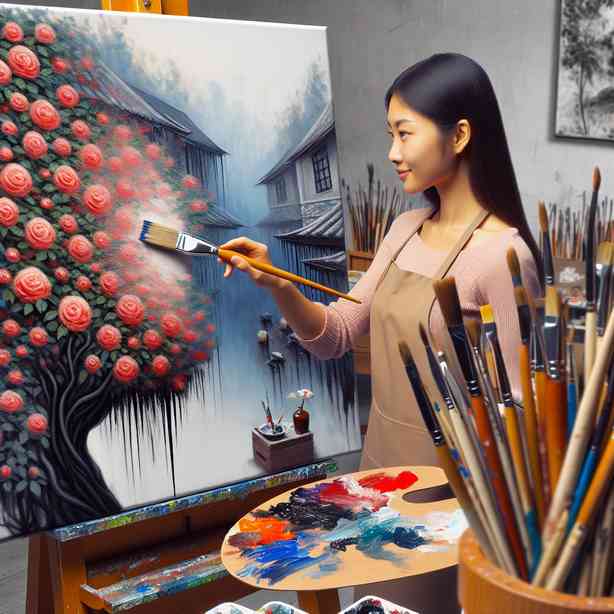
When you purposefully use the wrong brush in art or any creative endeavor, it may seem counterintuitive. However, this approach can open up a world of unexpected outcomes and creative exploration that can enhance your artistic expression. The very act of stepping outside the conventional boundaries of your tools can lead to intriguing results that not only redefine your artistic style but also expand your understanding of materials and techniques.
In art, brushes serve as extensions of the artist’s hand, each designed for specific effects. A round brush, for instance, is perfect for fine lines and detailed work, while a flat brush can create broader strokes and sharp edges. However, what happens when you decide to swap them? When you reach for a seemingly unsuitable brush—a wide, flat brush for fine details or a small detailing brush for broader strokes—you might find that the results challenge your expectations and push your creativity beyond its usual limits.
Using the wrong brush on purpose invites spontaneity into your work. This practice can serve as a gentle reminder that creativity often thrives on experimentation and play. In a world obsessed with perfection, such an approach encourages you to embrace imperfections and the unexpected surprises that come with them. The resulting textures and forms can breathe new life into your creations and help you forge a more personal and unique artistic voice.
Another aspect to consider when using the wrong brush intentionally is the emotional connection that can be formed. When you step outside your comfort zone and work with tools that do not conform to conventional methods, you may find yourself more engaged and emotionally invested in the process. Art becomes less about the final product and more about the journey, allowing you to explore your emotions and thoughts in ways you might not have anticipated.
Additionally, choosing the wrong brush can lead to a series of happy accidents. The unpredictable nature of using an inappropriate tool can lead to delightful discoveries. For example, using a stiff bristle brush to apply watercolor can yield rough textures that enhance the piece’s depth and character. This experimentation teaches you to appreciate the beauty of unforeseen developments in your work.
Incorporating such unconventional methods into your practice can significantly broaden your creative toolkit. The experience gained from these ‘mistakes’ can inform your future work, making you more adaptable and innovative as an artist. When you discover what doesn’t work just as effectively, you learn to recognize and appreciate the nuances of your favored tools and techniques. The exploratory journey not only provides insights into your preferences but also fosters growth.
Moreover, using the wrong brush also links back to the essence of art as a means of communication and expression. Your choices as an artist reflect your thoughts, feelings, and perspectives. By embracing unexpected methods, you might uncover new ways to convey your messages. Each stroke, even those created with the ‘wrong’ brush, carries meaning and intention, ultimately culminating into a rich narrative that transcends the visual elements.
Importantly, while the idea of using the wrong brush may seem liberating, it’s essential to balance this approach with an awareness of your artistic intent. Being intentional about your choices—even when they are unconventional—can lead to more meaningful artworks. This balance allows for a more profound engagement with your practice while still allowing space for spontaneity and exploration.
Additionally, consider collaborating with fellow artists who may have diverse approaches and techniques. Engaging in discussions about unconventional methods can provide new perspectives that inspire your own practice. Sharing experiences of using the wrong brush or other tools can lead to innovative ideas that transcend individual styles. Whether it’s through organized art classes, community events, or online forums, the collaborative energy can further fuel your eagerness to experiment.
When you intentionally use the wrong brush, not only are you challenging the traditional norms of your craft, but you’re also asserting your identity as an artist. Each decision reaffirms your uniqueness, reminding you that art is subjective; what appears to be a mistake to one may be viewed as inspiration by another. This mindset can foster resilience—teaching you to adapt, reevaluate, and reinvent your techniques and ultimately connect with your audience on a deeper level.
Finally, the process of pushing beyond traditional boundaries can lead to a deeper appreciation of the fundamentals of your craft. By experimenting with brushes and tools that don’t align with your usual practice, you create a richer dialogue with your work. The knowledge garnered from these trials and errors informs your future endeavors, reinforcing the idea that art is as much about the process as it is about the product.
In conclusion, when you choose to use the wrong brush on purpose, you embrace a form of creative freedom that invites experimentation, spontaneity, and personal growth. This encourages a refreshing perspective on artistic practices, allowing for rich discoveries and opportunities for self-expression. So, next time you find yourself reaching for a brush, consider stepping outside the norm and explore new possibilities. The wrong brush might just be the right choice for your next masterpiece, unlocking a realm of creativity you hadn’t previously imagined. Embrace the journey, cherish the surprises, and watch as your artistry flourishes in beautiful, unexpected ways.


